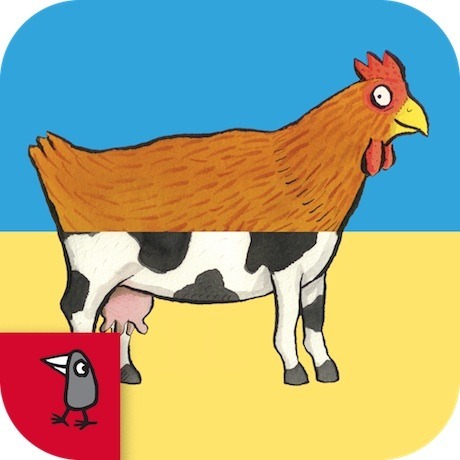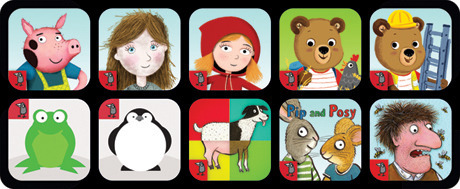Nosy Crow's Blog, page 199
September 26, 2013
Little Red Riding Hood is a Parents' Choice Gold Award recipient!
Our Little Red Riding Hood app is the recipient of a Parents’ Choice Gold Award! It joins our other fairytale apps, The Three Little Pigs and Cinderella, in being recognised with the highest honour that Parents’ Choice bestow. Gold Awards are given to products that are “judged as the highest quality, most appealing products in their genre. Criteria for judgments include the highest production standards, universal human values and a unique, individual quality that pushes the product a notch above others.”
Our Little Red Riding Hood app is a completely new take on the classic fairytale – for the first time ever, you can create your own story by choosing from multiple paths through the woods to reach Grandmother’s house, resulting in a new, fully-animated adventure with different endings every time.
Here’s what Parents’ Choice had to say about Little Red Riding Hood:
“Nosy Crow has once again transformed a beloved fairytale into an instantly classic iPad app … Nosy Crow works with perfect voice actors who endow each character with gentle attentiveness … Small interactive flourishes give little ones an active role in the story … Though you might know how the story ends, you and your children will still enjoy seeing Little Red Riding retold by Nosy Crow.”
You can read the full review here.
Here’s the trailer for Little Red Riding Hood:
And here it is on the App Store for $5.99/ £3.99.
If you’d like to stay up-to-date with all of our new apps, you can join our Apps Announcement Mailing List here. And don’t forget, we’ve just released our eleventh app, Axel Scheffler’s Flip Flap Farm! Swipe any part of the screen to create 121 different animal combinations in this fantastic rhyming app for pre-schoolers – here it is on the App Store for just 99¢/ 69p.

September 25, 2013
Come to our October reading group!
We’re making plans for our October Reading Group, and we’re going to shake things up a bit for the next event! This time around, rather than discussing a single title, we’ll be talking about a group of three books collected around a common theme. This month the subject will be illustrated fiction, and we’ll be reading Claude on the Slopes by Alex T. Smith, Dixie O’Day: In the Fast Lane by Shirley Hughes and Clara Vulliamy, and our very own Hubble Bubble: The Glorious Granny Bake-Off by Tracey Corderoy and Joe Berger.
We’ll also be meeting at a slightly different time of the month to usual (as the Frankfurt Book Fair is interrupting our normal date), and so this time the group will take place on Tuesday October 15 (but still at 6.30pm), here at the Crow’s Nest (10a Lant Street).
Some things aren’t changing, though – we’d still love it if you took part online, either through Twitter, with the #NCGKids hashtag, or on The Guardian’s website, where there’ll be a page for discussion.
If you would like to come, send me an email (tom@nosycrow.com) – we’ll post some questions for discussion closer to the date. Claude on the Slopes and The Glorious Granny Bake-Off haven’t been published yet, but they will have been by the time of the group – you can pre-order Claude here and Bake-Off here, and buy Dixie O’Day here.
We hope you can join us!

September 24, 2013
Our apps in the new Kids Category
A little while ago we we wrote about iOS 7, the new mobile operating system for the iPhone, iPad and iPod Touch, and one of its most important (for us) new features: a Kids’ Category on the App Store.
iOS 7 – and the Kids’ Category – launched last week, and we were absolutely overwhelmed by the level of support for Nosy Crow.
The picture at the top of this post shows a page of promoted Interactive Kids Stories from the US App Store (you can visit the page here, if you have a US iTunes account) – Apple’s selection of the best storybook apps for children. And of the 38 apps listed, TEN (count ‘em!) are by Nosy Crow – over a quarter! We think this is pretty good: we’ve only made eleven apps in total, and the only one missing… isn’t a story app.
We’re also one of the very, very few developers (the others are the likes of Disney) to have our own, branded page on the App Store, dedicated exclusively to our apps. Here’s a look at ours (with a wonderful, Nosy Crow-red background):
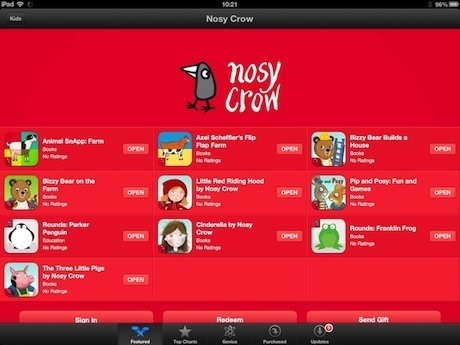
And elsewhere our apps are listed under categories including Best Apps for Ages 5 & Under, Best Apps for Ages 6 – 8, Learning Made Fun, Games for Kids, and more.
We’re truly amazed by all this: we really believe in each of our apps as innovative, engaging, extraordinary products, but we’re also a tiny, independent publisher (with fewer than a dozen apps to our name) and so to receive this degree of support from Apple is incredibly encouraging. It feels like we’re punching above our weight – and doing something right!
If you missed it, our eleventh app, Axel Scheffler’s Flip Flap Farm, came out last week – here’s the trailer:
You can find it on the App Store for just 99¢/ 69p here.
And if you’d like to stay up-to-date with all of our new apps, you can also join our Apps Announcement Mailing List here.

September 23, 2013
The verdict on our first conference, Everything You Always Wanted to Know About Children's Publishing (But Were Afraid to Ask)
As regular readers of this blog will undoubtedly know by now, on Saturday we hosted our first ever conference: Everything You Always Wanted to Know About Children’s Publishing (But Were Afraid to Ask). 150 people packed out the Bridewell Hall of the St Bride Institute in Central London – a whole mix of people who’d come to find out more about the industry: aspiring authors and illustrators, literature and literacy enthusiasts, students hoping to begin careers in publishing, as well as some Nosy Crow authors and illustrators:
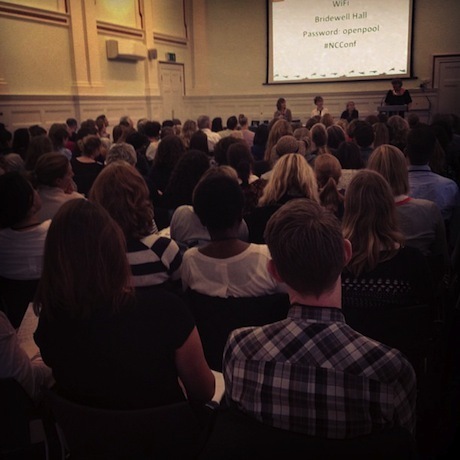
The view from the back of the room…
The day began (after the mild chaos of registration, some fleeting panic on my part at the sight of 150 very tangled lanyards, and a brief introduction by Kate) with a warm, funny and inspiring talk by The Guardian and Stylist Magazine columnist Lucy Mangan, on what children’s books mean to her.
Lucy spoke movingly about how reading changed her life and opened up her world growing up: how they taught her empathy, lessened her feelings of isolation, and provided comfort and insight into other worlds. And she said that she continues to read children’s books now, because “I’m too old to be bored.”
Lucy’s talk was followed by an Editors’ Panel, featuring Nosy Crow’s Head of Picture Books, Louise Bolongaro, Editorial Director, Camilla Reid, and Fiction Editor, Kirsty Stansfield (and chaired by Kate), and judging by the number of questions from the floor, and the amount of discussion on Twitter, it was clearly a highly anticipated session! Our editors explained how they spent their time, what the division of labour was between working on existing projects and searching for new talent, how the relationship and creative process with their authors and illustrators worked (and why it mattered so much), what they’re looking for (and what they don’t want to see), and how the editorial process is different at a smaller publisher like Nosy Crow compared to a Big 5 behemoth.
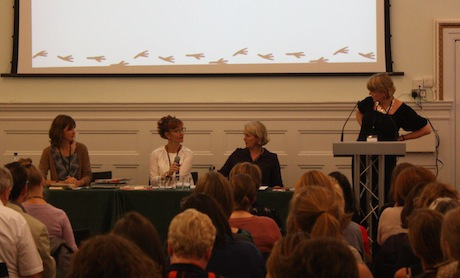
After a short coffee break, agent Hilary Delamere gave an absolutely BRILLIANT talk explaining exactly what an agent is “for” – informative, engaging and very interesting. Hilary wove a fascinating narrative out of every stage of an author’s career, from the time they send their work off to an agent, to the moment film rights are negotiated, and by the end of it I’d decided that I’d quite like to be represented by her, in fact.
The following session provided a intriguing counter-point: a panel of three (un-agented) Nosy Crow authors who’ve gone from our slushpile to having their work sold in countries across the world, winning awards and earning rave reviews: Helen Peters, Paula Harrison and S.C. Ransom. For large swathes of our audience it was obviously a particularly inspiring discussion, full of insight into the journey of a first-time author.
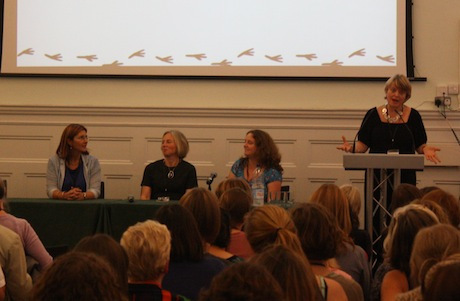
After lunch – and plenty of networking – author Tracey Corderoy gave another of the stand-out sessions of the day: a hilarious, passionate and deeply knowledgeable talk on the importance of live events for authors. Tracey spoke brilliantly about wanting to leave children with memories that will last them for a lifetime: that she knows how “grey” childhood can be, but that books and authors can bring colour into it – and over the 70 events that she’s done this year alone, she’s certainly introduced a lot of colour: dressing up as a bunny rabbit, a mermaid, a princess (but not a dragon – the costume wouldn’t fit in the car), at bookshops, schools, and festivals, she’s an absolute event-pro (and she had the audience in stitches).
If Tracey illustrated how important physical, face-to-face interaction could be for authors, Jon Reed, the next speaker, demonstrated the equal value of the other side of the same coin: how authors can use social media to market their books, build an online brand, and share their message with an audience. Packed with advice and useful tools, his talk was an invaluable one for anyone who wanted to learn more about digital communication.
The penultimate session of the day came from Melissa Cox, New Children’s Titles Buyer for Waterstones, and covered the commercial realities of bookselling with profound knowledge, wit and enthusiasm. No-one has a better sense of the whole children’s market in the UK than Melissa, and her talk practically exuded commitment to the industry. She spoke about how Waterstones chooses what to buy and promote, how to balance balance big names against undiscovered talent, how to make books stand out, what trends have emerged in recent years, and what booksellers are looking for, and had the audience hanging on every word.
The final event came from Kate, who spoke about the Future of Reading and Nosy Crow’s digital publishing programme – an inspiring end to the day and a look ahead to the ways in which reading is changing for children, what that means for authors and publishers, and what has stayed the same: the importance of storytelling.
And on that inspiring note, our audience re-convened to the next room for a glass of wine and another chance to chat, before heading home after a very long day!
If you’d like to follow more of what went on, there are a couple more blog posts on the day here and here, and you can also find a very good record of the day as it happened with the #NCConf hashtag on Twitter. Collected below are Alastair Horne and Imogen Russell William’s tweets from the day:
[View the story “Everything You Always Wanted to Know About Children’s Publishing (But Were Afraid to Ask)” on Storify]
So, overall, the day felt like a great success: a lively and enthusiastic audience, fantastic speakers, and a happy, engaged atmosphere (with plenty of cake).
If you were there on the day, thank you for coming! We’d love to know what you made of it – please do leave a comment below! And if you’d like to stay up-to-date with all of our book news, you can subscribe to our monthly newsletter here, and we’ll alert you to any new and upcoming events that we’re planning.

September 20, 2013
Our first conference is taking place tomorrow!
Tomorrow’s going to be very busy for us: we’re hosting our first conference, Everything You Always Wanted to Know About Children’s Publishing (But Were Afraid to Ask) – a whole day of talks devoted to de-mystifying the industry. We’ve got some incredible speakers lined up from all sectors of publishing – agent Hilary Delamere, Waterstones children’s buyer Melissa Cox, social media expert Jon Reed, columnist Lucy Mangan, a number of our authors, and members of the Nosy Crow team.
And even if you can’t make it to the event itself (we’ve been sold out for some weeks), we’d love it if you take part online! You can follow all of the day’s action on Twitter with the #NCCONF hashtag – and you’ll even be able to ask questions of our panellists during some talks.
If you have a burning question for one of our editors or authors, you can put it to them on Twitter during our panel sessions and we’ll do our best to answer as many questions as possible!
At 10.45, Editorial Director Camilla Reid, Head of Picture Books Louise Bolongaro, and fiction editor Kirsty Stansfield will be answering questions about the editorial process on a panel chaired by Nosy Crow Managing Director Kate Wilson.
At 12.30, Nosy Crow debut authors Helen Peters, S. C. Ransom, and Paula Harrison will be taking part in a panel session about first-time publications.
And at 16.30, Kate and Tom Bonnick, Digital Project and Marketing Manager, will be talking about the future of reading and Nosy Crow’s innovative app programme.
You can read our full schedule for the day below (and download it, and our full list of speakers, as a PDF here).
The hashtag is #NCCONF – we hope you can join us!

September 19, 2013
25 Years of Ten-in-the-Bed
It came as quite a shock to me to discover that it has been 25 years since Penny Dale’s much-loved picture book, Ten in the Bed, was published by Walker Books. I was surprised because it still looks as fresh today as it did when it was released, way back in 1988. Now it would be a big fib to say that I remembered it as a child, but I did read it to my own kids (again and again and again…) and it is one of those books that you somehow never get bored of reading. It’s this, more than anything else, that is the mark of a true classic. Like all of Penny’s books, it is a wonderful blend of her careful observational drawings and her flights of fancy, resulting in a book that we can both identify with and be transported by.
Anyway, to celebrate the book’s 25th anniversary and the fact that it has sold nearly 2 million copies, the Illustration Cupboard Gallery in London’s Piccadilly recently hosted an exhibition of artwork from the book, which includes the original artwork used in the book and some of the working drawings. It was a great tribute to a fantastic title. We are, of course, delighted and proud to be publishing Penny’s Dinosaur books and, fingers crossed, they too will be going strong in 25 years’ time!
A 25th anniversary edition of Ten in the Bed is available in bookshops now, and you can order it online from Waterstones here. And here’s an early look inside Penny’s upcoming picture book, Dinosaur Rescue, out next year:

September 18, 2013
What crazy creatures will you meet today? Our new app is out now!
Last week we wrote about the upcoming launch of iOS 7 and the new Kids’ App category of the App Store – and we also said that we had some new things to announce. Well… here they are!
MOST excitingly, our new app is out today!
We’ve made an app of Axel Scheffler’s Flip Flap Farm, the hilarious rhyming flip-flap book that we published in print format this month, with artwork by Axel Scheffler.
Instead of the split-page, spiral-bound format, our app uses a wonderfully intuitive, user-friendly interface: you can swipe any part of the screen to create 121 different combinations of animal halves, rhymes and silly, hybrid animal names – all read aloud and set to farmyard music.
Here’s the trailer for Axel Scheffler’s Flip Flap Farm:
And here it is on the App Store, for just $0.99/ £0.69.
You’ll have to use the app yourself to see quite how satisfying it is: a fantastically simple concept, a clean design, rich artwork from Axel and very funny poems – and all for less than a dollar.
Here’s what to look for on the App Store:
Share your favourite animal combinations from the app with us on Twitter with the #flipflapfarm hashtag and we’ll give away copies of our other apps to our favourites!
And that’s not all! To mark the launch of iOS 7, we’re also giving some of our existing apps a bit of a refresh with some brand new icons. Here’s how they’ll appear on the App Store from today:
The updated apps also include some features that we think will improve your experience of using them, like a new “gating mechanism” across the whole catalogue which is designed to prevent a child from inadvertently accessing the “More Apps” page of each app – so you can feel safe knowing that our apps won’t cost you a fortune.
If you enjoy Axel Scheffler’s Flip Flap Farm, or one of our other apps, we’d be incredibly grateful if you’d consider leaving a review on the App Store – it’s so important to us. And if you’d like to stay up to date with our upcoming apps, you can sign up for our Apps Announcement Mailing List here.
We hope you enjoy Axel Scheffler’s Flip Flap Farm!

September 17, 2013
We are all born storytellers: a 20 month-old tells a Pip and Posy story
Margaret Atwood, speaking on yesterday’s BBC Radio 4 programme, Start the Week, spoke about humans being born storytellers.
She said (9 minutes and 45 seconds into the programme), “I think we are storytellers by nature. And if you look at what children do before the age of, say, four, they will spontaneously understand stories even before they can talk. So we come with that as part of our package – as we come with music, as we come with an interest in images. We pick up language spontaneously. We pick up stories. And I think it must be very, very old, and doubtless conferred an advantage upon us… [It’s] part of our human inheritance.”
(And on the same programme Vicky Featherstone, speaking of storytelling in the theatre, said that she was struck by how whole audiences shift in their seats when storytelling in the theatre goes awry. “They know more than we do that something isn’t going right with the story… If it’s not firing on all cylinders and the story needs a bit of editing or a bit of focus, the audience shifts and they feel it physiologically. And that fascinates me, how deeply ingrained our understanding and need for story is.”)
I entirely agree that we are born storytellers, and story-understanders. I speak about this a lot when I am asked to speak to audiences about digital innovation in publishing, and what stays the same even when media change: the need for story is one of the things that doesn’t change.
A good example of a child as a story-understander, and a storyteller, was sent to us this week by Pam Lamberti, who lives with her husband and daughter Amber in South Africa.
This is what she wrote in her email:
“Hi, Kate
I found your details on the web and hope I am contacting the correct person. I trust you can pass this on to Axel Scheffler.
I want to share a video of my 20 month-old daughter Amber reciting her version of Pip and Posy: The Super Scooter. It is her favourite book by far and she recites these lines to everyone she meets! All of our friends know the answer to the question, “What happened to Posy?” We hear, “Pip helped her,” numerous times a day! A huge thank you to Axel for creating this stunning and engaging book for toddlers. We plan to add more books from the series to our collection soon. The Super Scooter has brought much joy to my daughter all the way down here in sunny South Africa.”
And here’s the video of Amber, which I find fascinating. It’s clear that her parents have gone beyond the text of the book to reinforce Amber’s understanding of the story, discussing the pictures and the story with her. there is no mention in the text of the fact that Pip provides a sticking plaster for Posy, for example, but we see it happening in the picture.
What we can see in the video is, clearly, a sort of “catechism” that Amber knows by heart, and it reminds me of one that my daughter learned at 17 months, not from books, but in our attempt to prepare her for a life-changing event:
Me: “Mummy’s going to go…”
Daughter: “To hospital.”
Me: “And when she comes back she will have a…”
Daughter: “Tiny baby.”
Me: “And you will be a…”
Daughter: “Big sister!”
(I wish I could say that I felt that my toddler grasped the import of the story she and I told together in the way that Amber seems to have cottoned on to what’s happening in Pip and Posy, but actually the shock on her face when she did meet her baby sister for the first time suggests that she did not realise that our exchange had real-life implications for her!)
Anyway, the point is that, at 20 months, Amber is already telling us stories.

September 16, 2013
Mountains to Sea
Last weekend some Nosy Crows were at the Mountains to Sea festival in Ireland – and today we’re very pleased to have a guest post by Tom Donegan from Mountains to Sea, looking back on a fantastic series of events. All pictures © Mountains to Sea dlr Book Festival 2013.
Ireland’s Mountains to Sea dlr Book Festival welcomed a flock of Crows to Ireland last weekend! MD Kate Wilson was invited to give a talk on the future of children’s digital publishing ’Reading the Future’, and take part in a related panel event- ‘Great Ad-app-tations: The Picture Book and Beyond’- discussing the cutting edge of children’s publishing … and what lies ahead.
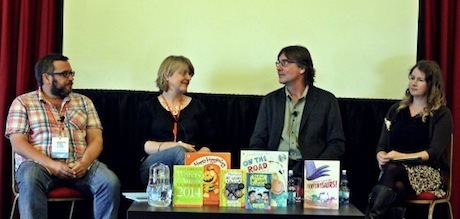
Photo by Ger Holland © Mountains to Sea dlr Book Festival 2013
Meanwhile, Bearded Nosy Crow author Philip Ardagh was invited along to delight hundreds of school children with tales of his hilarious series The Grunts, illustrated by Axel Scheffler … and delight he did!
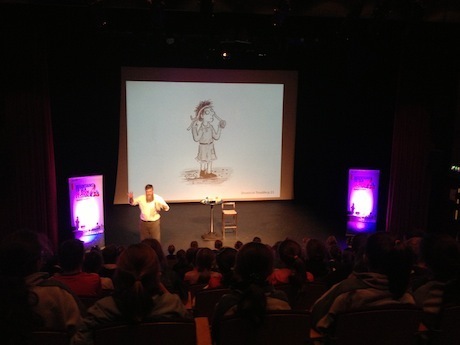
We like to take good care of our guests at Mountains To Sea and both Kate and Philip were warmly welcomed and well looked after. Philip, especially, was keen to sample some Irish specialities, names a few creamy pints of his favourite monochrome beer (it really does taste better over here!). Kate’s was more of a flying visit, but feedback from both events has been excellent and we’re very grateful to them both for attending.
So, as the sun sets on another successful Mountains to Sea, our eyes are already turning to 2015 (the festival is taking a break in 2014) and you’re all very welcome to join us next time around!
Thank you, Tom – we’re looking forward to returning next year! Here’s the first chapter of The Grunts all at Sea, the second book in The Grunts series.
Order the book online.

September 13, 2013
The Nosy Crow Guardian Reading Group verdict on Fruitloops and Dipsticks by Ulf Stark
Last night the fourth summit of the Nosy Crow Guardian Reading Group convened to discuss Fruitloops and Dipsticks by Ulf Stark. This book represented, as we’ve noted here on the blog before, a number of firsts for the group: our first book in translation, our first book with a female protagonist, our first book with a first-person narration, and (although we didn’t realise this when we chose the book) our first book not to have been published recently (although the English translation was published in 2010, the original Swedish text was first published in 1984).
It was also, it transpired over the course of the evening, the most polarising book we’ve read for the group, and the one that would provoke the most debate of all of our choices so far. Whereas A Monster Calls and Wonder were both more or less unanimously loved (or, at least, liked) and A Boy and a Bear in a Boat was largely met with, at the very least, admiration for some of its technique (if not its pacing), Fruitloops and Dipsticks inspired a wildly opposing range of reactions: some people felt that it was brilliant, and others hated it so much that they didn’t want it in their house.
So, before I carry on, I should say that the following summary of the evening’s discussion will contain spoilers. And I should also say that Kate (who wrote the summaries for our previous events) is a much better note-taker than I am, and so this post may not be as admirably comprehensive as her entries have been. And without further ado, onto the book.
Who’s the book for?
One question on which a number of us did agree was that pinpointing the audience for this book was a difficult thing to do. One of our two groups broadly agreed that this was “a book for girls” (but also questioned the wisdom of a middle-aged men writing about pre-teen girls’ sexuality). The second group was willing to concede that the intended audience for the book was certainly children, but no-one could easily picture a child who would necessarily enjoy it.
There were a lot of questions about the “appropriate-ness” of the content of the book, particularly in the context of the age of the characters: there’s smoking, swearing, and nudity, which one of our members (a primary school teacher) noted would mean that she wouldn’t give it to any of her pupils. Some people felt that the treatment of these topics was particularly Scandinavian, and others that it was a product of its time (the ’80s) – either way, I think we all acknowledged that it would contain a certain “foreign-ness” for a contemporary British reader, and especially a child reader.
Translation, style, and other thoughts on language
A big focus throughout the evening was that this work had been translated from Swedish: what impact that had on the story and the characters, on the prose, and on our relationship with the text. Whilst everyone essentially agreed that reading books in translation was a great thing for children to do – as a means of broadening their horizons, exposing them to other worlds (“so that you’re not trapped inside your own culture”), and showing them things from different perspectives (which, as I write it, I sort of release is what I think all books should do, actually) – there wasn’t quite such unanimous assent that this book in particular was one that could boast all of these benefits.
Whilst everyone agreed that Fruitloops and Dipsticks seemed very noticeably like a work in translation, there was some dispute about whether this was a positive or negative aspect. A number of people enjoyed the “quirkiness” of the language, which they felt to be particularly Swedish (a word that was often used as a synonym for slightly cold or clinical), and one person observed that although they could tell that the book has been translated, this “didn’t feel jarring”… whereas someone else questioned whether the translator even spoke English as a first language (noting that the passive voice felt quite odd).
Several group members argued that the detached, somewhat impersonal tone added a nuance and subtlety to the narrative that would have been lacking had the book been originally written in English – and one person (who particularly enjoyed the book) thought that, had it been written now, and by a British writer, it would have been far less satisfying and more “sign-posted” in terms of its narrative arc and emotional journey. Several others, however, felt that the eccentricities and quirkiness of the characters meant that building relationships with them as a reader – and particularly with the narrator, Simone – took some time.
Characters and themes
Very few of us – in my group, at least – were able to succinctly convey what they felt Fruitloops and Dipsticks was “about”, other than in the most general terms: growing up, finding one’s identity, coping with change, adolescence – and a lot of us felt that the book handled these ideas rather skilfully: they are themes to which nuance and subtlety certainly acquit themselves well. There was, however, some frustration over the handling of the main “event” in the narrative, the decision (or lack thereof) of Simone to “become” Simon and act as a boy. Even those who particularly enjoyed the book felt that it could have done with a few sentences more to explain this circumstance, and I certainly thought that Stark owed his readers a bit more narrative justification here: it is something that Simone simply goes along with, and not – to my mind – in a way that is desperately convincing. Someone else thought that this aspect worked quite well, though – that it was a clever metaphor for gender being thrust upon you (it is certainly, I suppose, a powerful example of Judith Butler’s theory of performativity), and that the lesson that Simone learns is that she can still be a girl whilst also doing the fun, “boy-ish” stuff that she enjoys.
Simone’s passivity was widely seen as complicating what is – ostensibly at least – a first person narrative, and I’m not sure that anyone felt that the book was terribly convincing in this respect (or, more generously, that it simply takes a lot of poetic license in its narration). Simone seems to have access not only to a wider set of experiences than seems plausible, but is also – for someone who has only just turned twelve – extraordinarily articulate, so perhaps this a first person narrative in name only.
Is it funny? And other final thoughts.
Perhaps the area over which there was the most heated debate was whether we found this book funny. This is one of the places where I think the experiences of a child and adult reader would dramatically diverge: the parts that we found funny would not, I think, be at all the same for a child. Several of us enjoyed the understated, dry humour of the book, as well as parts of Simone’s internal monologue, and the irrationality of some of her actions and behaviour, but when asked to identity what we thought a child might laugh at, the scene that most of us named was the case of mistaken identity that takes place when Simone’s teacher visits her mother (which I found to be a somewhat odd departure from the rest of the book, tonally).
I think that the best description of our overall group reaction to this book came to us during the the last part of the evening: someone pointed out that the fruitloops amongst us liked it, and the dipsticks didn’t, which gets to the core of this text with admirable brevity.
Have you read the book? What did you make of it? We’d love to hear your comments, either on Twitter or below.
And although we haven’t announced next month’s choice of book yet, the group will meet on Thursday October 17 (one week later than usual) – and if you’d like to come, please email tom@nosycrow.com.

Nosy Crow's Blog
- Nosy Crow's profile
- 35 followers



